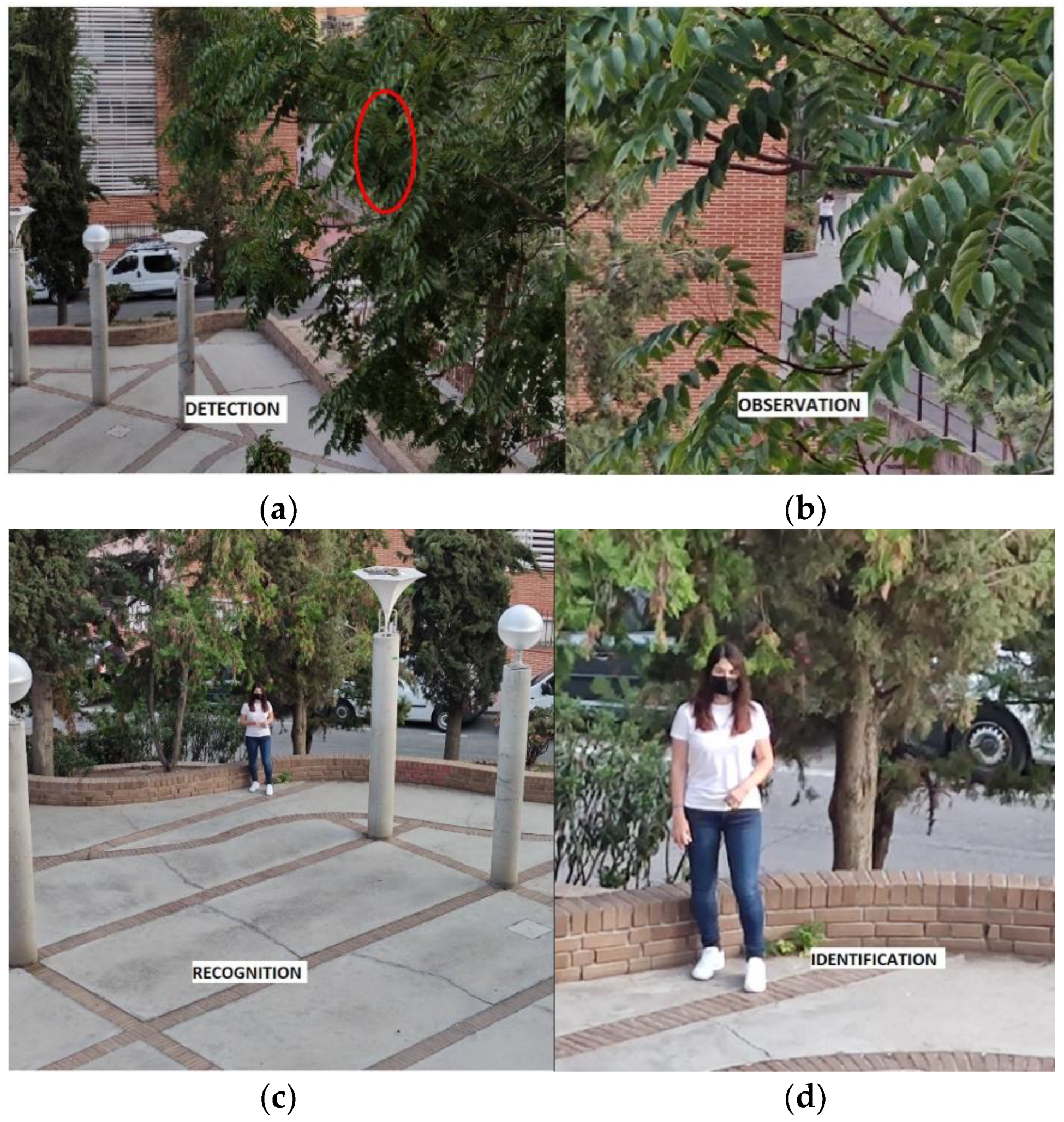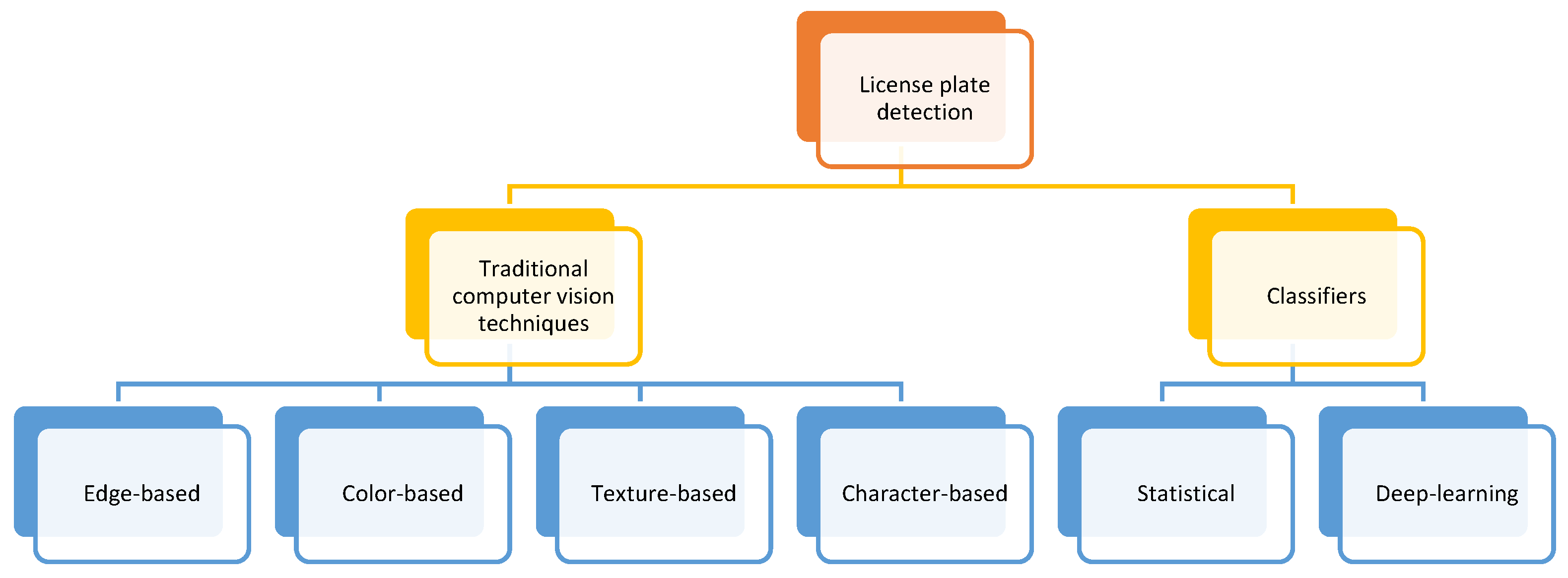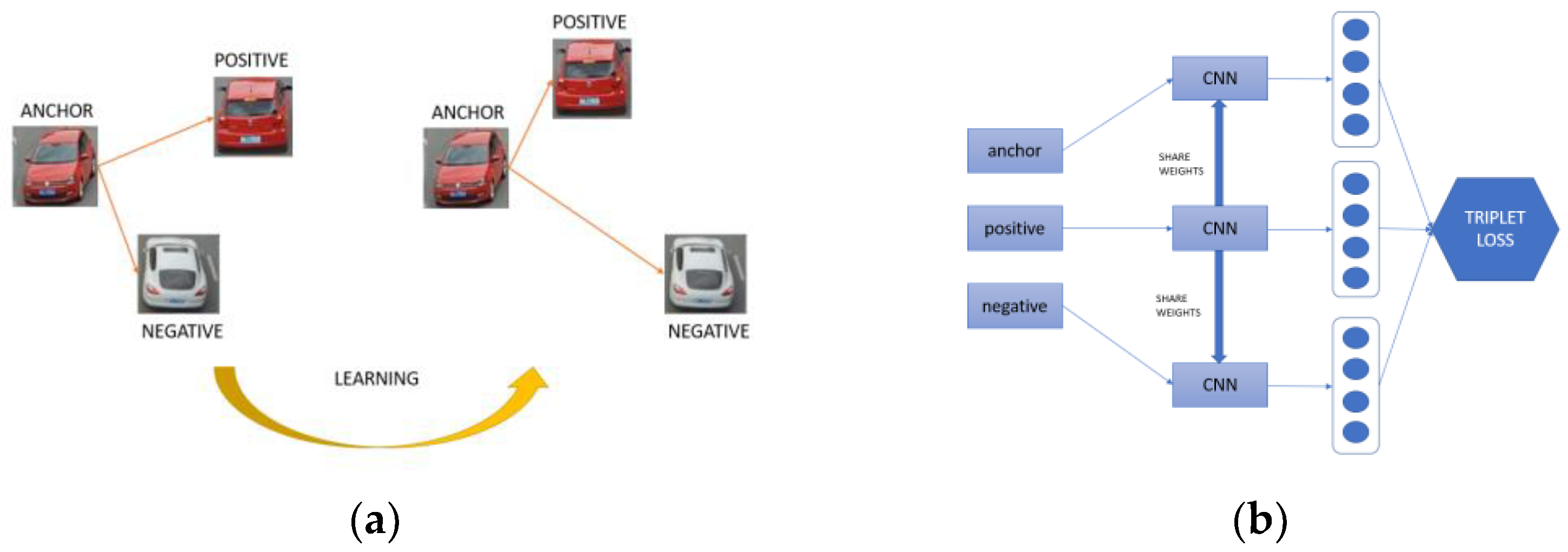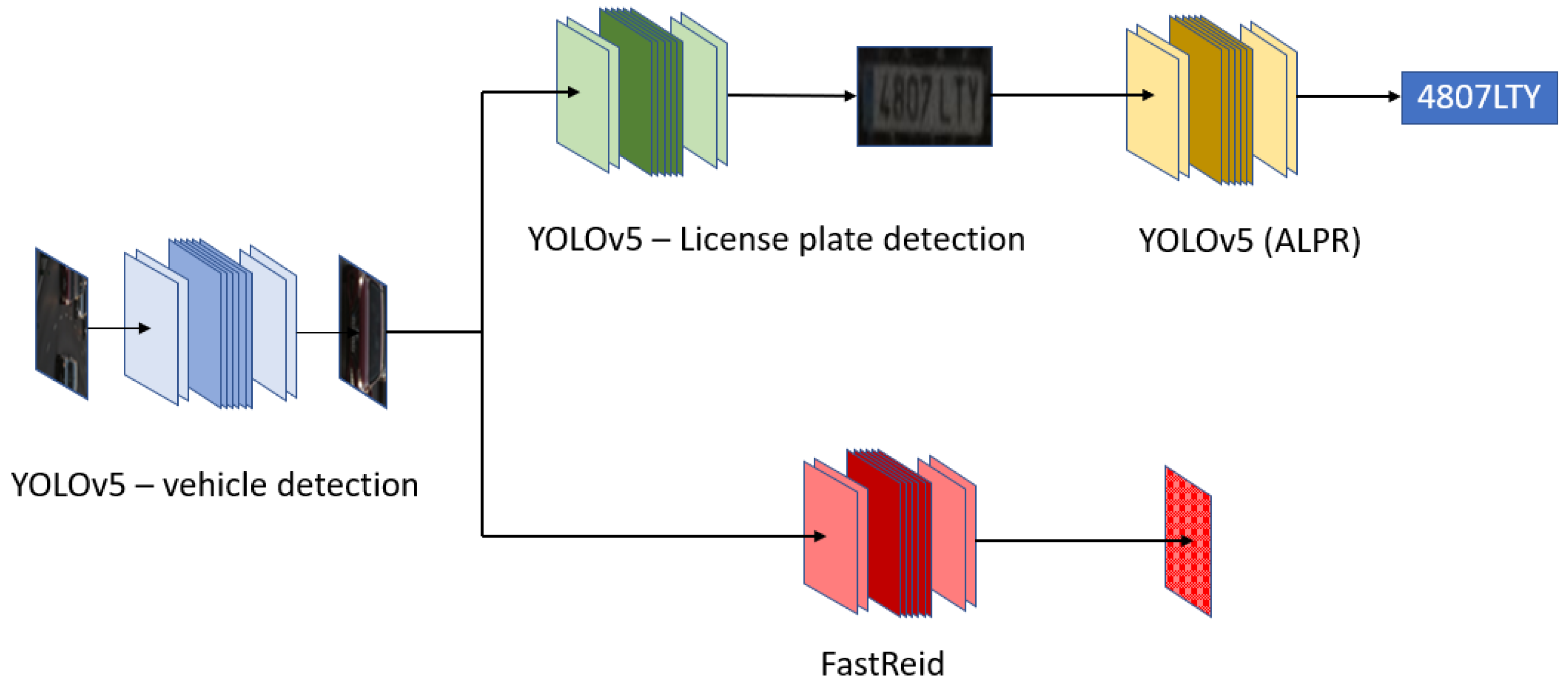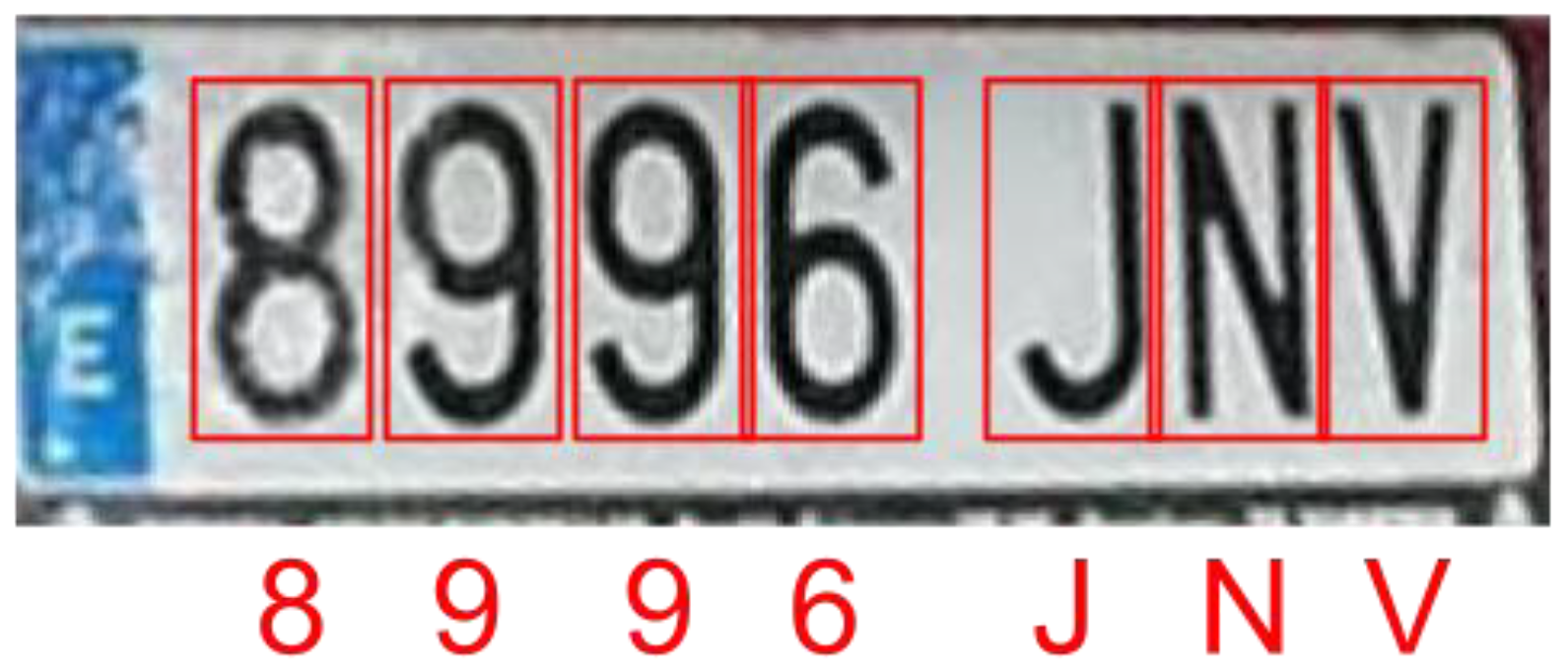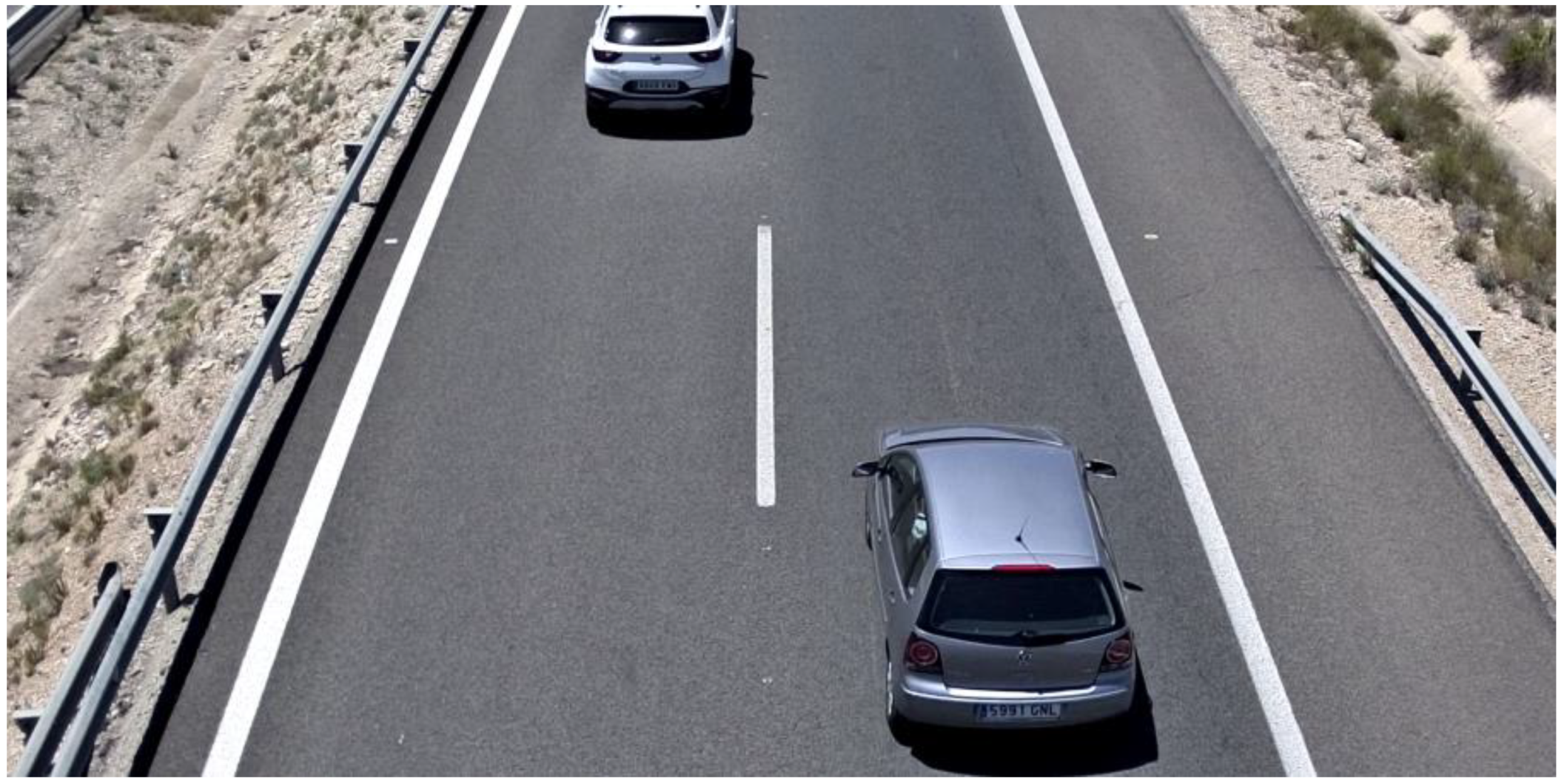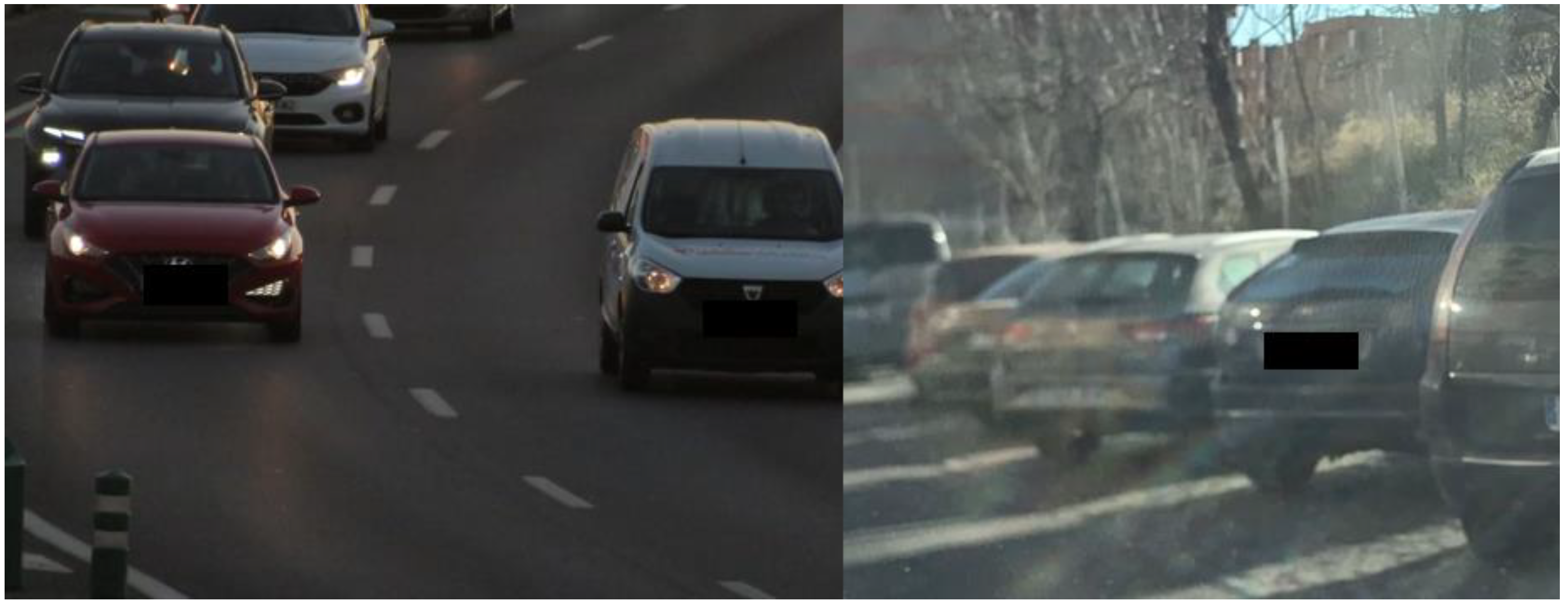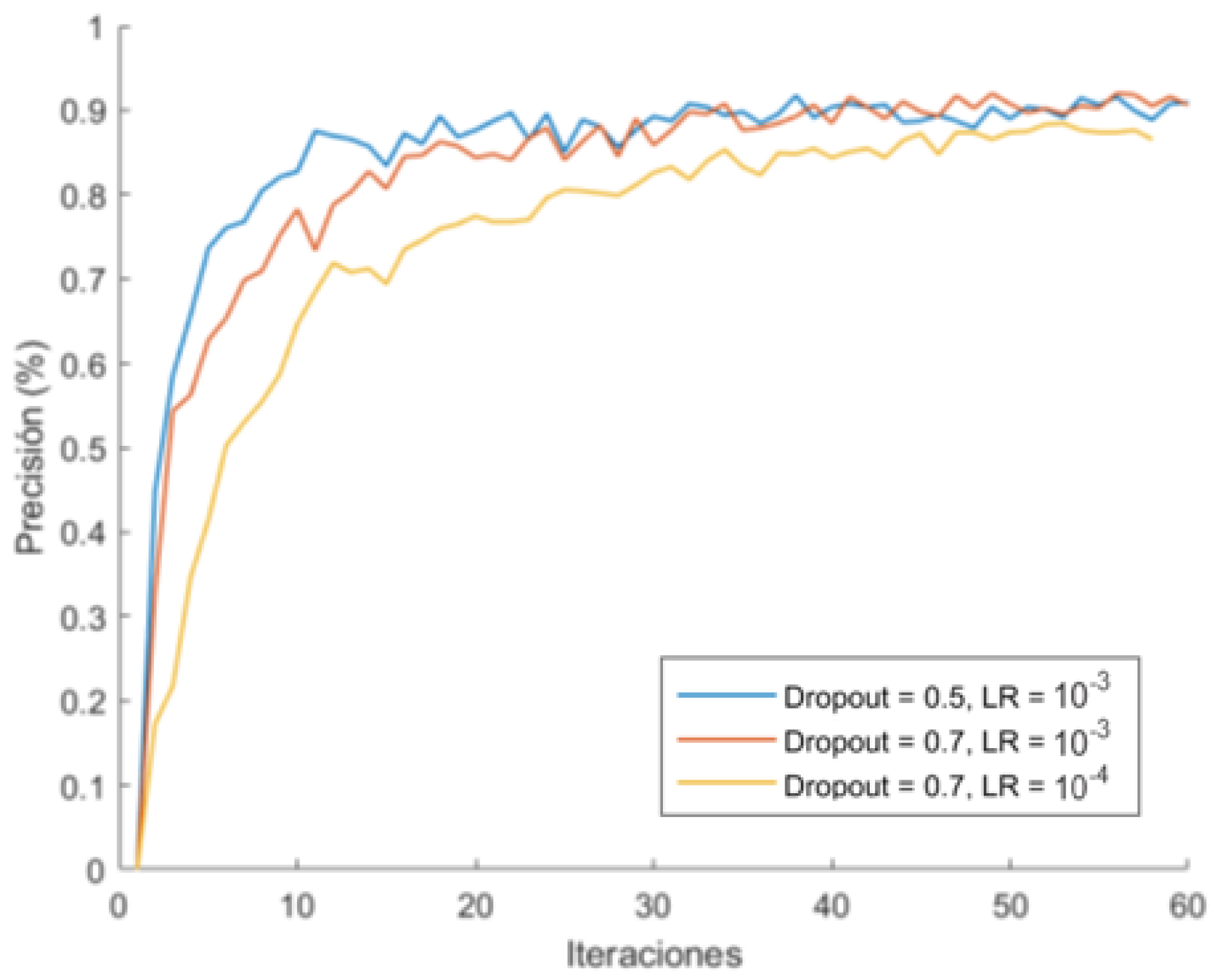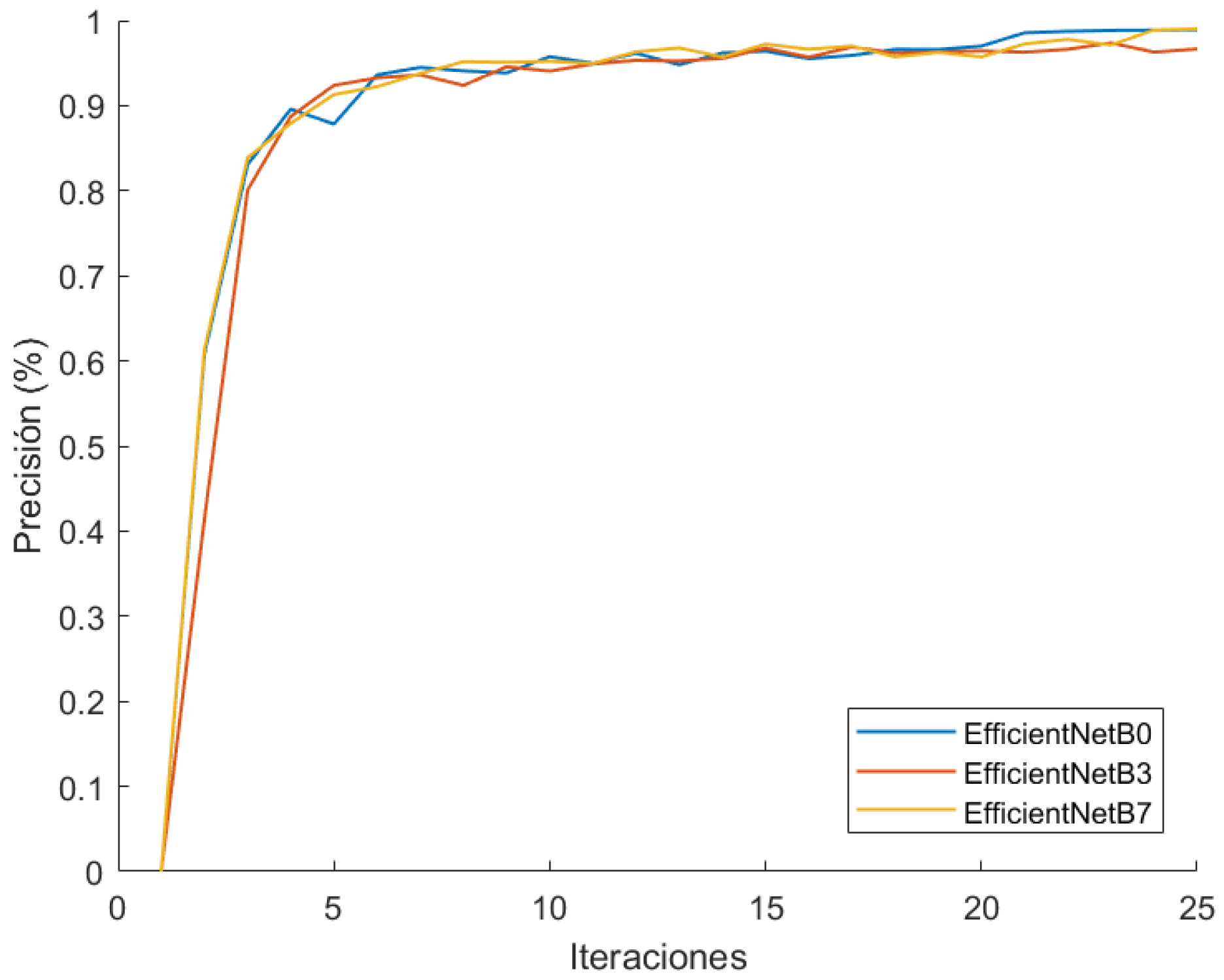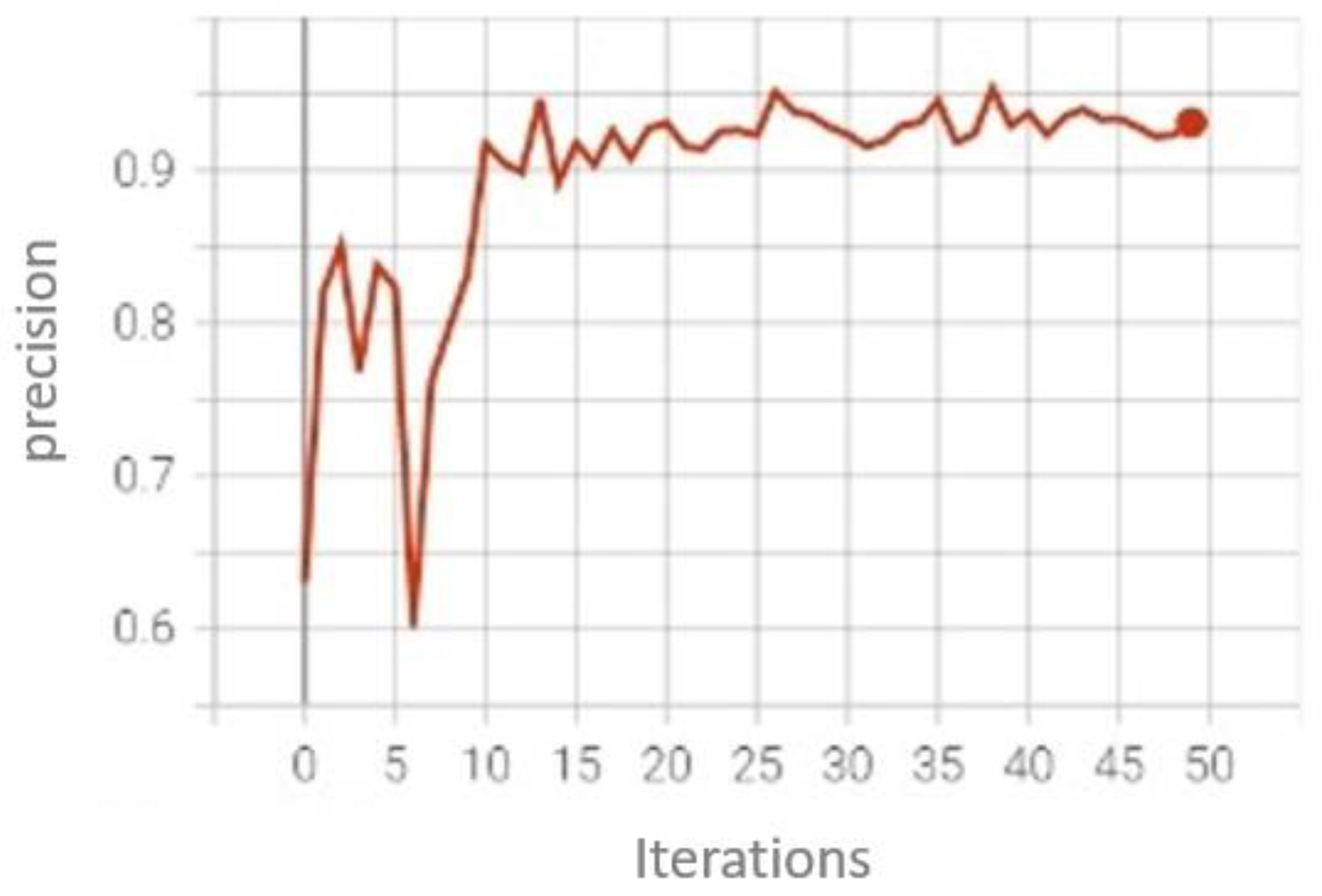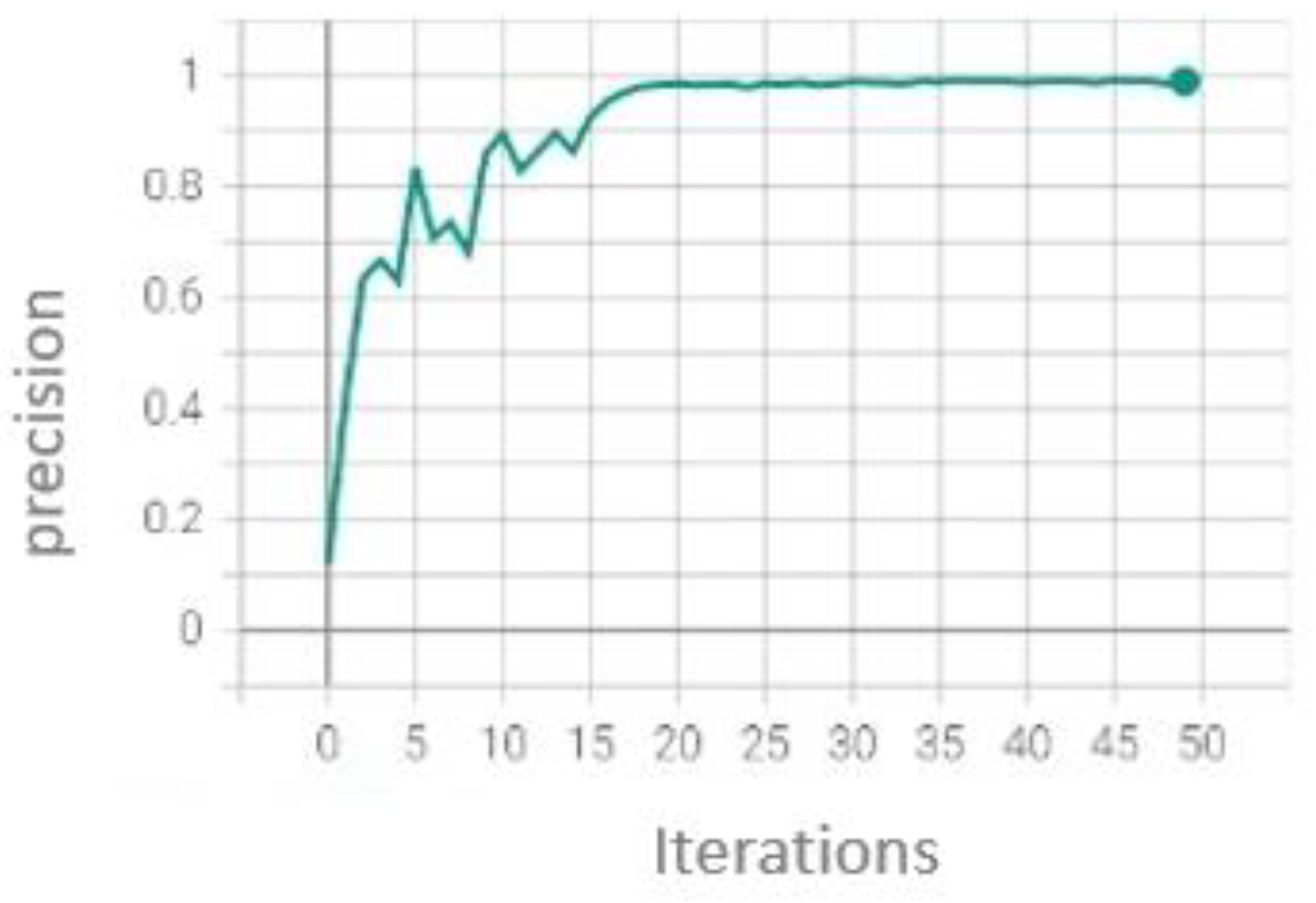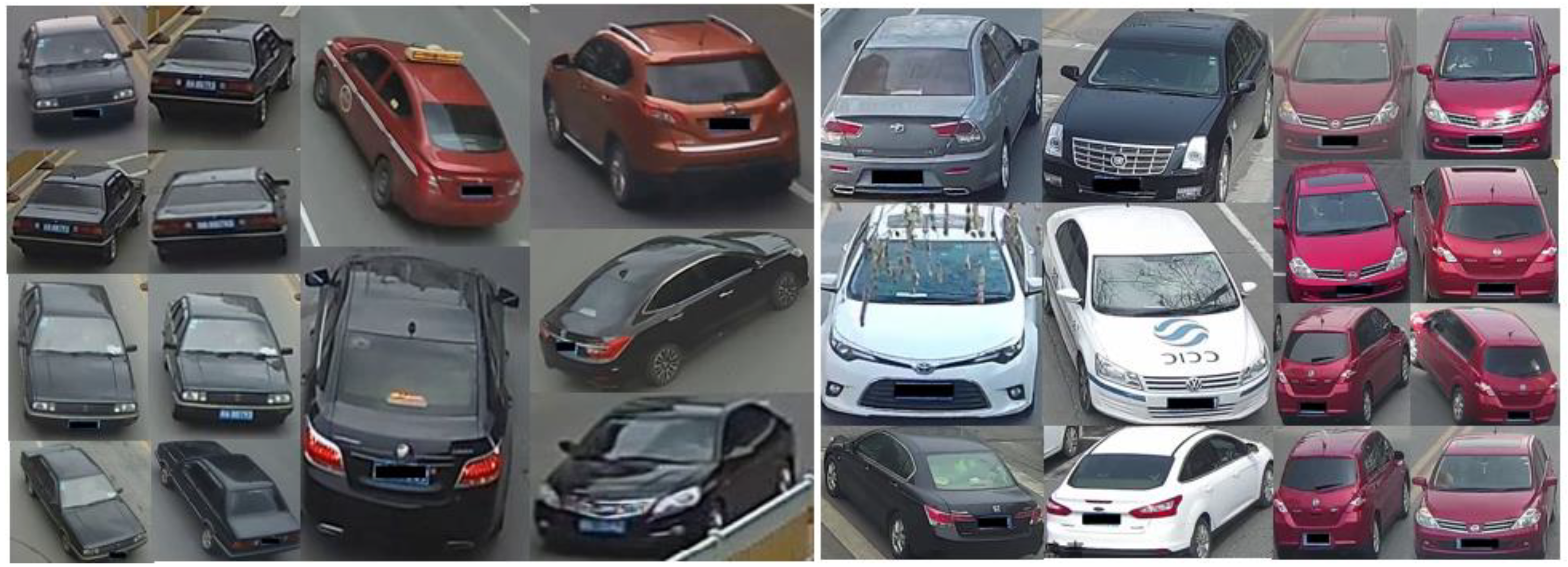1. Introduction
Surveillance systems are only one part of a complete security solution, which also includes several elements such as physical barriers or deterrents. Surveillance systems consist of different components such as video cameras, detectors or different IoT devices, such as trackers or smart sensors. This topic is extremely wide, and there are many areas that can be investigated in detail. In fact, it is possible to find several avenues of research from different points of view, such as [
1] or [
2], which provide an overview of the concept of surveillance systems.
Intelligent video surveillance systems would be a specific type of system, whose functionality is based on the combined use of images with signal processing methods. In particular, intelligent video surveillance is an important topic within video processing and computer vision, because of its potential in very different fields such as military, health prevention or public security [
3,
4]. In this case, this article will focus on vehicle identification that is applied to security by the means of intelligent video surveillance systems. In particular, a specific solution that tries to combine different capabilities will be presented, with the ultimate purpose of being robust against variable conditions.
1.3. Video Surveillance System: Uses
A video surveillance system could simply seem to be just a camera for monitoring a scenario. However, there are multiple factors that need to be considered, in order to design the most suitable system. The challenge is to identify all these factors and to manage all of them at the same time.
The first and the most important one is to define the purpose of the system. For example, it would not be the same if the camera is intended for traffic control, compared to robbery prevention. In the first case, the focus would be on cars; in the second one, the aim would be to collect as much detail as possible (such as license plates or faces).
The second factor is the study of the operational circumstances. This term refers to identifying whether our system, for example, will work only during the day, at night or over 24 h; if it will be installed inside or outside, or if we can have an electric grid connection or only a battery supply.
Last but not least is to determine whether or not our system will operate in real time. This is very important, because it will not only affect image transmission, but also the image processing method.
From the point of view of security, cameras have a dual purpose. On the one hand, they act as a deterrent. On the other hand, they are a fundamental element for investigations and crime solving. They are one of the main tools that are used to collect evidence that can be brought to court proceedings.
Precisely because of its wide variety of uses and configurations, the first step is to be clear about the targets. An excellent example can be a public car park. It is common to find several types of cameras within these scenarios. Some of them are focused on entry and exit access, and on capturing the license plates of vehicles (as shown in
Figure 1). Thus, they record the number of parked vehicles and the time spent inside the parking lot. The rest of the cameras are usually used for prevention, to avoid theft or damage to vehicles.
Focusing on the first types of cameras, they will need the capability for identifying and registering the license plates of the vehicles entering and leaving. To this end, all elements of the system shall be installed to obtain images of license plates with the highest possible quality and contrast.
In this specific scenario, the signal processing system will recognise the license plates, extract the characters, store them and register the different vehicles. The rest of the elements of the system will enable this task. Hence, the camera and lighting will be large, visible, and they will focus directly on the license plate. In addition, the work of acquiring the frames of the license plate is easier, thanks to the fact that the car must remain stopped until the process has been completed.
Most of security systems operate similar to this previous one. They are designed for controlled environments with static cameras installed, accompanied by large optics (which contribute to a better resolution in the image) and lighting systems that are designed to eliminate any type of aberration. However, these ideal circumstances are not always possible, such as, for example, on a highway.
1.4. Motivation: Identifying the Scenario and Looking for Solutions
The specific scenario in the use of video surveillance systems will be vehicle identification and tracking. The vast majority of commercial systems focus mainly on license plates. This is why most of them employ specific cameras to facilitate signal processing. However, there are many situations where these cameras do not work properly.
These situations can be mainly due to two factors: vehicles position in images and lightning conditions. The first one directly affects the information available in the frames obtained. For example, when a vehicle exceeds the speed limit while it is overtaking another car, a situation can happen where the speed trap captures both vehicles and it is impossible to obtain all of the characters of the license plate corresponding to the offender. Or, when a camera is monitoring a certain place such as a roundabout or a corner, it may happen that the sensors capture the image of the target car, but that the frame does not include the license plate.
The second scenario occurs when weather or lightning conditions affect the capacities of the sensors. By law, European cars have license plate backlighting. Although this was thought to facilitate license plate reading, it is very common in the evening or at night that this indirect light can burn the images captured, causing the opposite effect.
As previously mentioned, cameras are fundamental for investigation and crime solving. That being said, all of the information provided can be critical. A perfect example may be a robbery that is recorded by a security camera. Due to the above-mentioned scenarios, this camera may have captured images of the vehicle used by the offenders, but not its license plate. In this case, we have very important but incomplete information. Although this camera has not been able to read the license plate, maybe there is another one that could obtain the information in time. Without an automatic image processing tool, this may take hours or days, and time is a vital resource. The later that data is analysed, the less chance there is to capture the authors.
Some systems try to solve these problems by offering additional capacities such as detecting the brand or the colour of the cars (such as, for example, OpenALPR). This could be very useful, but it is not enough in some scenarios where, for example, we want to detect a certain vehicle while it drives along a motorway, and we need to determine where it leaves the motorway. On the other hand, many traffic control cameras do not have enough resolution to detect a car with just its license plate.
Vehicle tracking for security requires a high standard of precision. In fact, in critical situations where there is no margin of error, there will be always an officer verifying the information. A problem appears when there is a large amount of information to analyse. Linking with the robbery example, traditional license plate readers would not be useful because we do not have the license plate characters, and pure vehicle re-identification systems may provide too much information. However, a combination of both elements can guide the investigation faster because it would be possible to both synthesise the images of cars that can be matched to our target, and to know the license plate data. This is the main advance compared to other different solutions shown here that act in isolation.
Through this research, we want to look for a robust solution that not only improves license plate reading capacities, but also one that can be applied in a wide range of scenarios and that satisfies real needs in security systems that are used for vehicle identification.
1.4.2. Identification, Recognition and Re-Identification
In security, depending on the aim pursued, there are four levels of “precision”, called the “DORI concept” [
13] (acronym for detection, observation, recognition and identification). This standard, included in the IEC EN62676-4: 2015 International Standard, defines the resolution in pixels that an image must have, so that the detection, observation, recognition and identification of objects/people in images can be conducted in it. It is usually included by surveillance cameras manufacturers in their datasheets.
These terms are directly related to their size within a frame, and in turn, to their distance from the sensor. As we can see in
Figure 2, the closer the target is to the sensors, the more information we have regarding it, which implies a shift between the different terms mentioned.
Detection (
Figure 2a) is the ability of the system to capture some movement or event. This would be the first step to “activate” the perimetral security. It can be associated with a motion detection system. In fact, it is usually combined with physical sensors or with movement detection mechanisms (such as event alerts caused by pixel variations, or by infrared detectors). Using the first image as an example, detection would be the capability to detect a new active element; in this case, a person.
Observation (
Figure 2b) would correspond to the capacity to appreciate the possible movements of this new asset. It will allow for an analysis or a study of its “intentions”. As is shown in the second image, it is usually possible when the new target comes closer to the camera, which allows it to be seen with better resolution, but not enough to recognise it.
Recognition (
Figure 2c) is the capability to observe whether the asset is previously known or not. In this case, this term is usually linked with the CCTV operator, as this is the entity that is able to make this recognition. In
Figure 2, it is the distance or the number of pixels when the user is able to know who is in the images.
Finally, identification (
Figure 2d) is the ability to see enough characteristic elements in the image to make the asset recognisable on subsequent occasions. In the previous example, it is possible to observe enough of the person’s features to give an unambiguous picture of him or her (as in the images). These last two capabilities, recognition and identification, are the main objectives pursued by a video surveillance system. In fact, the vast majority of research lines have focused on developing these capabilities, exploiting the increment in the resolution of the sensors. The higher the resolution, the sharper the image, and the greater the distance at which that recognition and identification can be conducted.
The recognition and identification tasks developed by video surveillance systems tend to be mainly performed upon people and vehicles. To identify a person, there are different biometric characteristics that are individual and impossible to replicate, such as the face, voice, eyes or even the arrangement of blood vessels [
14,
15] (in vehicles, it is normal to resort to license plates).
All these systems need images with a minimum resolution to be able to fulfil their objectives. Hence, lighting mechanisms, and optics and sensors try to obtain the images in the best possible conditions, so that the treatment of these signals offers the best results. Even as they are different procedures, the operation behind them is exactly the same; that is, detect a face/license plate, extract it, and match it with a database to know who the vehicle’s owner is, or who that person is. However, is this an identification? Or is it really a recognition? In order to develop this idea, we must delve deeper into the differences between identification and recognition.
Due to the large computational cost required by the artificial intelligence algorithms applied, the vast majority of identification systems actually perform large-scale recognition tasks [
16]. An identification can be understood as a recognition in which a sample “n” collides with a base “N”, where “N” contains “n”, as well as a large number of elements.
For example, when referring to a facial identification system, the system does not really identify any faces. It will compare a sample against a very large database (such as an ID Card database). Faces are encoded as an array of unique and unrepeatable features, and compared with the rest of the features arrays stored.
The first case would refer to a classification network (such as the one explained in the previous section), in which there would be as many categories as the number of people among whom the identification is made. This generates a problem. Under a traditional approach, to perform a correct classification, it would be necessary to have a very specific dataset with as many categories as elements (faces) to classify. In addition, being very similar elements (faces), it is also necessary to have a very large volume of images. It is not the same that the classifier distinguishes between people and vehicles; for example, compared to only between different types of vehicles.
To simplify this problem, a different approach must be applied. For example, let us imagine an access control system with facial recognition. The system, when it has the frame corresponding to the person who wants to enter, will compare that face with those that stored in its database. That is, it will indicate whether or not that face is in the database. Broadly speaking, this problem can be understood as a binary classification, in where there are really two categories: yes (the image corresponds to one of the stored ones) or no (it does not correspond). Under this perspective, it is possible to simplify a classification problem to a mere comparison. This is called re-identification [
17,
18], and it is the approach chosen to develop our investigation upon.

